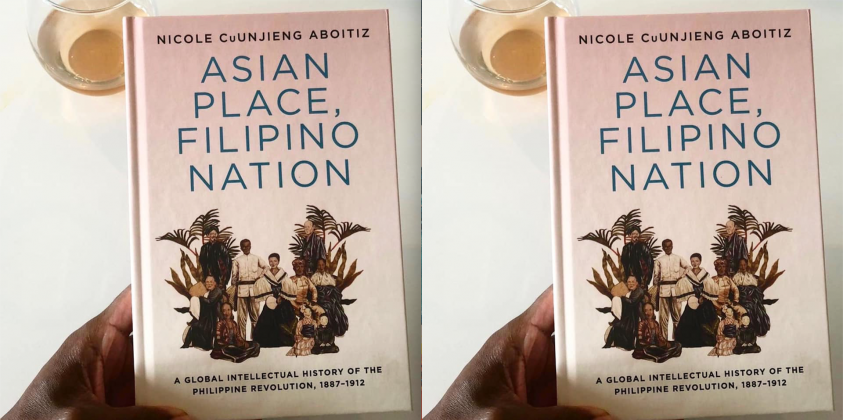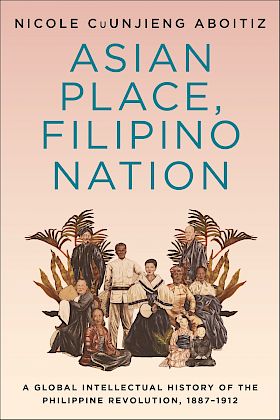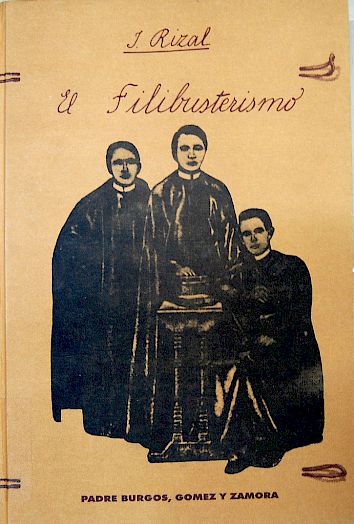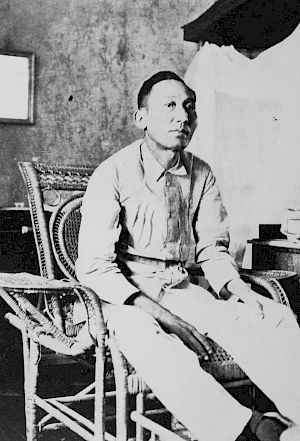The Philippine Revolution constructs ‘Asia’ and Civilization from the periphery

By Nicole CuUnjieng Aboitiz, Clare Hall, University of Cambridge
Filipinos, on the whole, are famously pro-American. In 2014, the Philippines topped the Global Attitudes Survey with regard to global public approval of the United States, coming in with a ninety two percent favorability rating.[1] In 2013, a higher percentage of surveyed Filipinos held America favorably and had confidence in the US President, including the former president George W. Bush, than Americans themselves held and had.[2] The entrenched, orthodox Philippine narrative of the Second World War presents the Japanese occupation of the islands as a Dark Age shattering the golden period of American colonial peace, prosperity, and tutelage toward independence. Reynaldo C. Ileto wrote that Pres. Sergio Osmeña “spoke of Douglas MacArthur’s return as a repetition of his father Arthur’s arrival in 1898 to free the Philippines from Spain,” and that Pres. Elpidio Quirino asked Filipinos “[w]hat was the ‘Death March’. . . if not the common pasyon or Christ-like suffering and death, of Filipinos and Americans?”[3] Yet not all Filipinos viewed Douglas MacArthur’s fulfilled promise in 1945 as the redemptive return of their liberating savior. Though they were a minority, it is nevertheless worth exploring those narratives—and asking how they came to be a minority.
What were the intellectual roots and political lives of that contrarian position? What intellectual histories have the streamlined national historiography shed? What alternative visions of political possibility emerge if one does not begin asking such questions in the second half of the twentieth century, when global American geopolitical and economic dominance naturalized a special relationship with the erstwhile colonizer as the most expedient, realpolitik for the postcolonial Philippine state?

The turn of the twentieth century is an important moment globally—with all the changes in technology, sovereignty, human exchange, and ideology that it wrought. It is also a deep turning point for a more concentrated area: Southeast Asia—with imperial subjugation and incorporation hardening empires and firing local resistance across the entire region. The Philippines is both singular and microcosmic in this, featuring a very early instance of the regional transition of power that would take place over the twentieth century—from the Old World, European imperial powers to the emerging, New World, American global power and the rise of Japan—as well as the brief creation of the first modern, secular, native republic in Asia: the First Philippine Republic. But, in 1872, at the start of the period I studied, two decades prior to the First Philippine Republic and three decades prior to American colonization, Las Filipinas is, still, one of the final vestiges of the fading Spanish Empire.
The diverse islands of Filipinas are riven with ethno-linguistic variety, and the contours of what would become the Philippine nation-state were in no way presumed. What geographies of political affinity and what intellectual histories of place would attend the Philippine Revolution and the construction of the Philippine nation? Despite the fact that this is the single most studied history in all of the Philippine literature, answers to such questions are sorely missing from the historiography or have been stymied by Eurocentric assumptions. Indeed, the transformative late nineteenth and early twentieth centuries are too often apprehended in Asian historiography through a bilateral framework privileging relations with the West. Beyond merely the Philippines, meanwhile, I wondered: how do anti-colonial and proto-nationalist constructions of ‘place’ relate theoretically and genealogically to empire and imperial claims to space?
Colonized by Spain and the United States, the Philippines has long been considered closer to Latin America than to Asia, but do the islands’ important transnational and comparative histories run only along imperial lines—only with/against their former colonizers and those colonizers’ former colonies/possessions? What could such postcoloniality in our analysis be obscuring? The traditional assumption of the literature is that the Filipino self-image is historically non-Asian—seeing itself as belonging, instead, to the Western hemisphere. Many early postwar/Cold War Southeast Asian studies, such as D.G.E. Hall’s seminal work A History of Southeast Asia (1955), excluded the Philippines from the Southeast Asian ambit of scholarly consideration. This begs the question: what is Southeast Asia? For that matter, what is Asia? Existing at the “periphery” and serving as the litmus test for both, the Philippines is a singularly rich site to explore such questions.

In tracing the intellectual genealogy of the Philippine nation, I excavated what turned out to be far more complex theoretical and historical bases to the construction not only of the Filipino, but also of Asia, race, and a concept of place that could challenge imperial claims of rightful sovereignty. My book Asian Place, Filipino Nation: A Global Intellectual History of the Philippine Revolution, 1887-1912 (Columbia University Press, June 2020) investigates precisely what ground the Philippine nation built itself upon intellectually, excavating its neglected cosmopolitan and transnational Asian moorings in particular, in order to reconnect Philippine history to that of Southeast and East Asia. It also recovers the “periphery” of the discourse of Pan-Asianism, which was built on material aid and the fantasy and affect of transnational anti-colonial Asian solidarity. The book seeks to make that periphery legible to the center and to expand our discursive, East Asia-centric understanding of Pan-Asianism more generally.
For the ilustrado (educated elite) Filipinos, who constructed the Philippine nation through their Propaganda Movement, and the succeeding revolutionaries, who sought to enact it through the Philippine Revolution and First Philippine Republic, one of the central theoretical problems that their nationalism needed to work through was that of civilization. This was because their intellectual armature and politics of the proto-nation had to grapple with then-current Social Darwinist interpretations of history and geopolitics, which had conventionally placed Filipinas as uncompetitive and unfit for self-rule. Their Social Darwinist interpretations of universal history and the place of Asia, however, subverted the racial denigration usually associated with Western Social Darwinism, revealing the anticolonial and emancipatory possibilities embedded in the discourse. How would the Filipinos appropriate, construct, and reimagine Asia towards these ends? Though the book ranges widely in its study of the various intellectual histories attending the Philippine Revolution, today, I wish to draw attention exclusively to the Filipinos’ construction of Asia through a historical argument on Civilization. It is no small matter, for despite the traditional assumption that Filipinos have historically seen themselves as non-Asian, this argument about universal Civilization and identification with Asia formed a ballast of their claims for anti-colonial nationalist sovereignty.
The Propagandists inscribed the new Filipino nation they were seeking to construct within a more ancient Asian landscape, imbued with a civilizational importance that would be recognizable even to Europeans. They apparently thought this association with an older, richer documented civilizational realm necessary, due to the visible lack of ancient kingdoms and ruins around which Filipinos could assemble their nationalism. It was also a way to counter the argument of Spanish and European thinkers who described the archipelago as overrun by an anarchy of tribes and races. In the Propagandists’ mouthpiece, La Solidaridad, Asia largely appears as constructed through the history of Civilization, and is noted for its heights of achievement—albeit in a defensive tone.

https://www.flickr.com/photos/nccaofficial/18256265679
An important feature in their construction of Asia through the history of Civilization was the premise that there is something like universal Civilization, and that it merely passed from one incarnation to another, from East to West and back again. This ephemeral, unitary concept of Civilization formed the mechanism by which the civilizational construction of Asia reconciled itself with the history of the rise and fall of great powers and the current state of material inequality between East and West. The national hero José Rizal discussed the civilizational tenet in his article on May 15, 1889:
…Religion, civilization, science, laws, and customs came therefore from Egypt, but in travelling along the pleasant shores of the Elaides, they were shorn of their mystic robes and they put on the simple and charming clothes of the sons of Greece…All their learning, science, philosophy, fine arts, and literature passed on to Rome, losing something of their grace and beauty, but gaining in return grandeur and majesty which reflected the genius of a proud nation. The same thing that happened to Rome is happening today to civilized nations in relation to Gallicization. Hellenism was introduced everywhere, its poetry and its music were transmitted from mouth to mouth; its customs and its mores were copied and practised. Science and civilization had been until then the patrimony of the Orient, but following the natural course of the stars, it directed its step to the Occident, and when it got to the heart of the world, it tarried as if to draw all nation and races together.[4]
From here he spoke explicitly of the uses of travel and of learning from others, while he implicitly worked to reinscribe the East into the history of high civilization. Indeed, this is precisely the theoretical premise and intellectual moves that would characterize the Japanese-sponsored World War Two wartime Philippine President Jose P. Laurel’s historical and political thinking, and that grounded his Pan-Asianism.
The Philippine revolutionary and First Philipine Republic’s Minister of Foreign Affairs Apolinario Mabini’s writings echoed the thinking on race, Asia, and universal civilization that Rizal the Propagandists articulated in La Solidaridad. “Please pardon me,” Mabini wrote his friend on November 3, 1899, “if I cannot agree with you that the cradle of mankind was in the neighborhood of the equator.”[5] After citing his reason based on the history of the passing ice ages and development of animal life, he clarified: “I think we find in the town near the equator not the cradle but the future of the human race.”[6] Mabini reasoned that God allowed for the existence of avarice because it gave him a tool through which to “extend civilization” and to eventually “humiliate the proud and exult the humble.”[7] This statement explains the existence of unequal progress across civilizations at different points in time, but unifies them as existing within a single universal narrative. He argued that it was the law of nature that the “route of civilization” leave wide tracks in the “vast field of history” passing from “Babylon and Phoenicia, now Syria, in Asia, Egypt and Carthage in Africa, Greece and Rome, in Europe; the United States, in America” onto the “Philippines, in Oceania.”[8] Universal civilization is carried continuously and housed by many, he believed, indifferent to whether it lands East or West, above or below the equator, geographically. This was not only civilizational, but in Mabini’s argumentation, racial. “It is true,” he wrote, “that the colored race, compared to the white race, is inferior up to the present in culture and civilization.”[9] But Mabini did not believe this state to be permanent, innate, or fixed. Slipping from race to culture, Mabini argued:
History teaches us that culture takes root, not to perpetuate itself in a certain locality, but to flower and bear fruit, in order that the wind may spread its seeds to all distant regions. Besides, in the same manner that the earth turns sterile with continuous civilization, to the point where the artificial fertilizer is no longer capable of giving life and substance to new plants by such a superior process, a society with a rich life and corrupted customs, which brings always abuse to refined culture and towards which man is always inclined, weakens and degenerates until it lacks the necessary vigor to continue advancing up the road of civilization.[10]
It is at this point, he asserted, that the youthful vigor of a new nation takes up the mantle of civilization. “Present and future wars will serve for the aggrandizement of the races that now groan under the weight of ignominy and slavery,” he warned.[11]

https://en.wikipedia.org/wiki/File:A_mabini.jpg
Of the Philippines, he declared: “When this young nation, full of strength and abundant in love, inherits the experience of another which is already old and worn out, the sciences will advance greatly and will humanize, so to say, the sentiments to the extent required by the aspired universal equilibrium.”[12] In this manner, Mabini theorized a role for inequality of progress across cultures—it allowed for the inevitable process of creeping decadence and decay not to stifle universal civilization. At the point of decay, a youthful, adapted, different nation would take up the mantle of universal civilization and breathe into it new life. In this way, Mabini’s thinking on universal civilization advanced that of the Propagandists.
The Propagandists’ theorization of universal civilization had turned to history in order to diminish the importance of the Philippines’ perceived cultural and racial inferiority (which they now theorized as a temporary, historicized state) as well as to tie the Philippines to a history of past and universal greatness. Mabini then took their theorization of universal civilization, which was oriented toward the past, and built into it a causal process that predicted the Philippines’ future greatness. This intellectual move mirrors the one that took place more broadly in the transition from the Propaganda Movement to the Philippine Revolution. The Propaganda Movement had established a foundation for a Filipino nation built upon “reclaimed” Asian history and a “reawakened” racial Malay consciousness, thereby drawing from the past to buttress the grounds, the place, upon which a Filipino nation could stand. The Philippine Revolution took this intellectual armature, which was oriented toward the past, and prescribed a future for it, theorizing and mobilizing the action that would achieve it.
Book available at: https://cup.columbia.edu/book/asian-place-filipino-nation/9780231192156
[1] https://www.pewresearch.org/fact-tank/2014/07/15/which-countries-dont-like-america-and-which-do/
[2] https://www.rappler.com/nation/56085-philippines-usa-pew-research
[3] Reynaldo C. Ileto, “World War II: Transient and enduring legacies for the Philippines” in Legacies of World War II in South and East Asia, ed. David Koh Wee Hock (Singapore: Institute of Southeast Asian Studies, 2007), 84.
[4] Laon Laan, “Los Viajes,” La Solidaridad I, 7 (May 15, 1889).
[5] Apolinario Mabini, “Letter to Remontado: November 3, 1899,” in The Letters of Apolinario Mabini (Manila: National Heroes Commission, 1965), 231.
[6] Ibid.
[7] Ibid., 232.
[8] Ibid.
[9] Ibid.
[10] Ibid.
[11] Ibid.
[12] Ibid.